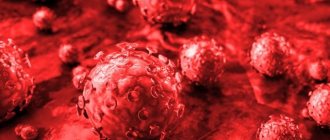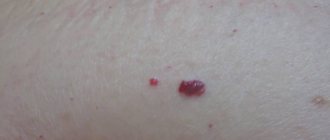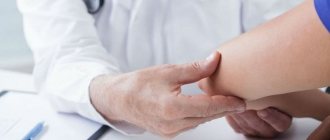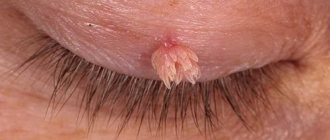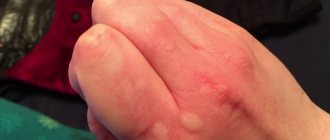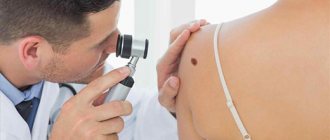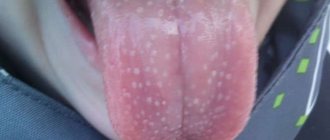Introduction
A viral wart is a benign growth on the skin that is caused by the human papillomavirus.
The disease is called HPV, or simply human papillomavirus infection. Today this virus is the most widespread, 90% of the world's population is infected with it. More common in women. 130 strains have been registered, 90 of them affect the skin and mucous membranes. It is impossible to completely recover from PVI.
Why are growths dangerous for humans?
Are growths on the hands dangerous? Any neoplasms must be treated. You should not start the development process to avoid negative consequences. What is the danger of warts?
Danger:
- Possible spread to other areas of the skin,
- Trauma can lead to the spread of the papilloma virus throughout the body,
- People around you can also get sick if they come into contact with a sick person.
- There is always the possibility of the growth degenerating into an oncological form.
In addition, the tumor should always be removed if it begins to change or bleed. Sometimes warts go away on their own, but in most cases some therapy should be carried out.
What virus provokes the appearance of growths?
The HPV virus is highly specific to humans; it infects and transforms basal epithelial cells (keratocytes). The most common causes of viral warts are HPV types 1, 2, 4, 27 and 57. HPV types 3, 7, 10 and 28, 41, 65, 88 and 95 are less commonly detected.
- Types 1, 2 and 4 are detected with plantar warts;
- 2, 4, 26, 27, 29, 57 - for vulgar;
- 3, 10, 28, 49 types – for flat ones.
In the cells of the basal layer, the virus can remain latent for a very long time. The process of HPV replication begins only when favorable factors appear.
Description of growths, location: arms, legs, fingers
A wart is the most common form of HPV manifestation. It is a formation on the skin in the form of a nodule, often flesh-colored or light brown, ranging in size from 1 to 10 mm. Also read how to trim a plantar wart in a child, symptoms and treatment.
The growth can be single or multiple. Its shape is round, dense and convex, with clear boundaries. First, the main wart appears - the maternal one, and then daughter warts form around it.
The growth of warts in most cases is slow, they gradually grow and protrude to the surface. At first they do not cause any symptoms, so it often seems to a person that papilloma appears suddenly. Depending on their location, warts subsequently become injured, hurt and bleed.
Treatment of viral warts
The basis of treatment is the removal of warts by the application of caustic agents, cryosurgery, electrodesiccation, surgical excision and laser ablation. Conservative therapy consists of local application of various ointments that promote the resorption of warts.
Essential drugs
There are contraindications. Specialist consultation is required.
- Tebrofen ointment (antiviral agent). Dosage regimen: to remove flat and simple warts and molluscum contagiosum, first rub in 3-5% salicylic ointment 2 times a day, and then vigorously rub in 5% tebrofen ointment again. The ointment is used for at least 2 weeks.
- Colchamine ointment (antitumor agent). Dosage regimen: apply 1.0-1.5 g of 0.5% colhamine ointment with a spatula to the surface of the wart and surrounding tissue in an area of 0.5-1 cm, cover with a gauze cloth and seal with an adhesive plaster. The dressing is changed daily; at each dressing, carefully remove the remaining ointment from the previous lubrication and disintegrating tumor tissue, make a toilet around the tumor. The disintegration of the wart usually begins after 10-12 smears. The course of treatment lasts 18-25 days. After stopping the application of the ointment, apply an aseptic (sterile) bandage for 10-12 days and thoroughly clean the wound.
At what age can they appear?
Typically, warts appear in young people between the ages of 18 and 30 who are sexually active - in the case of anogenital warts. In recent years, the number of anal papillomas has increased due to the growing interest in anal sex.
They often appear after 40 - then they talk about age-related warts. Children very often have warts due to bad habits (biting nails and sucking fingers), they very actively explore the world and put everything in their mouth.
Even babies are not immune from HPV if the mother has genital growths. Infection occurs during childbirth. This is often expressed in laryngeal papillomatosis, which can result in obstruction.
Important!
To become infected, the virus needs an “entry gate”: microcracks in the skin, scratches, abrasions.
In children
The frequency of warts in children is associated with their high activity - they are very mobile, often fall, play and tinker in the sandbox, dive into bodies of water, etc. In these conditions, they are often without shoes, and minor skin lesions are common.
Warts in children develop in a unique way, this is due to the thin layer of the epidermis and delicate children's skin. First, a whole cluster of small, flattened, flesh-colored elevations appears in one place. There are larger ones in the center. More often they start from the fingers and then spread further.
In adults
In adults, warts are often associated with their profession - cleaning premises, garbage collection, agricultural work, etc. These people more often than others expose their skin to microtraumas, which sometimes go unnoticed. Adults are characterized by a single arrangement of viral growths.
Warts have a wrinkled, rough surface. In their development they go through several stages: latent, active and aging.
At the last stage, they transform into dense, keratinized nodules. In this form they may disappear. 70% of warts disappear on their own, 2 years after their appearance, but with the same success they return to other places.
What is and ICD-10 code
Viral warts are small pathological growths. They do not cause discomfort. If the elements are located in hard-to-reach places (genital, anal area), patients may not know about their existence for a long time. When rubbed or damaged, they begin to bleed.
The viral type of warts has code B06 according to ICD-10. Human papillomavirus infection is characterized by a chronic course.
There is no complete cure for HPV. The virus constantly persists in the body.
Favorite localization is epithelial cells. Here the pathogen grows, feeds, and reproduces. When favorable conditions occur, the papillomavirus provokes the proliferation of modified cells.
According to the international classification, there are several types of viral warts caused by HPV:
- Ordinary - characterized by a round shape, rough surface, flesh color. The formation grows up to 3 mm. Vulgar papillomas are common in childhood. In the literature they are found under a different name - juvenile. The formations are located on the elbows, neck, and axillary area.
- Plantar – localized on the feet. They affect the toes and heels. A characteristic feature of this type of formation is the internal rather than external growth of a viral wart. Unlike other foreign elements, spines exhibit severe symptoms. Patients complain of pain in the soles of their feet when walking. Gradually, the symptoms of infection subside. The condition must be differentiated from calluses.
- Anogenital - characterized by a long incubation period. Appear a few months after intimate contact. Appear on the genital and anal area.
- Papillomatous - appear in children. They grow inside the larynx. The large size of the viral wart leads to obstruction. The child may suffocate.
What are they and what do they look like?
Doctors distinguish the following types:
- Ordinary (vulgar) – the shape is convex-rounded, small, flesh-colored, dimensions do not exceed 3 mm. The surface is rough. This is the most common form - up to 70%. In most cases, they are located on the fingers, palms, and back of the hands due to frequent damage or contact with potentially contaminated objects.
- Plantar calluses resemble dry calluses, which is why they are called dry warts. They constantly experience pressure from a person’s weight, so they grow not outward, but inward, in the form of a thorn. As a result, internal tissues are damaged and cause severe pain. People call this type of growth “spurs” or “spikes.” As the pain hardens, it becomes chronic.
- Flat or youthful - differ little in color from the skin. They mainly occur in children and adolescents on the bends of the elbows and knees, neck, and chest. They are flattened in shape, protrude slightly above the skin level, no more than 3 mm in size. They can be confused with moles or freckles.
- Genital condylomas or anogenital - occur during sexual intercourse and appear after a few months. The incubation period is long.
- Papillomatous - grows inside the larynx. If large in size, they can lead to death from asphyxia.
Vulgar
The causes of such papillomas are types 26–29, 41, 63, 77 of the virus. The neoplasms are not malignant. First, discomfort in the form of itching and burning occurs at the site of the future, then papillomas appear - spherical growths.
The color is flesh-colored at first, then darkens. Size - no more than 1 cm, rough, slightly raised above the skin. Most often they appear on the hands, thighs, and in infants - on the knees. Can be single or multiple.
Dry
A dry wart is a growth on the inside of the palms, feet and fingers. The formations are hard, yellowish in color, similar to calluses. Caused by HPV types 1, 2 and 4.
Dry warts are more common in those who wear uncomfortable shoes or neglect hygiene rules in public places. The growths often hurt, itch, and lead to changes in gait.
Considering them calluses, many do not go to the doctor. At the initial stage, the pain is felt only when stepping, walking, then it becomes constant. A plantar wart always has several black dots - these are sealed vessels. There is no skin pattern on it - this is its main difference from a callus.
Flat
Occurs more often in children than in adults. Flat (intradermal) papillomas practically do not protrude above the skin and have a wide base. Called by types 3 and 10. The shape is round or oval flesh-colored formations. Tend to merge. The growths are located on the bends of the limbs, neck, and in the armpit area.
Flat papilloma
Filiform
They have a thin and narrow specific leg. At first they look like a small bump, which soon stretches out. They hang in the form of flesh-colored skin mushrooms.
Caused by HPV types 7 and 2. Appear after 40 years. Localized on the neck, upper eyelids, groin, under the arms, in the groin area and under the mammary glands. Easily and often injured by clothing or careless movements.
Nail area
Periungual warts are a type of simple wart. They spoil the appearance of your hands, although they do not pose a threat.
Most often caused by type 2 virus. Such growths affect the skin of the nail cuticle or are localized under the plate. They look unaesthetic, so many of their owners strive to get rid of them quickly.
Most often, this disease affects people who constantly bite their nails, tear off cuticles and work without protective gloves in an aquatic environment. Also, such growths occur in children who constantly suck their fingers.
Senile keratomas
Seborrheic (senile) keratosis is the appearance of benign formations on the surface of the skin. In other words, this is a non-inflammatory increased keratinization and thickening of the upper layer of the epidermis of the skin, which is accompanied by a slowdown in the exfoliation of dead cells.
As you age, your skin has less collagen, so it loses its elasticity. Wrinkles appear on it, it dries out, and cracks. But her changes are not limited to this. With age, spots also form on the skin: yellow, brown, in the form of plaques, growths, etc.
They peel, may itch, change color and size. Typically, such changes begin after 40 years. The growths appear in places inaccessible to the eye (back, neck, head), have no symptoms, and the person does not notice them.
Such changes are absent only on the palms and soles. And after 60 years, seborrheic keratosis occurs in 95% of people. Neoplasms can be single or multiple. They grow very slowly, are asymmetrical, non-contagious, and rarely degenerate, although this possibility cannot be excluded - 3.3% of cases. Special treatment is often not required.
How to get rid of a wart?
Also, today there is no specific treatment for warts on the hands. All treatment methods can be divided into:
- Surgical - scraping out the growth tissue using a scalpel under local anesthesia; this method is used extremely rarely today.
- Physiotherapeutic – laser removal of warts, liquid nitrogen, electrocoagulation
- Chemical - acids, alkalis
- Immunotherapy
- Folk remedies - celandine juice, onion, acetic acid, etc. (see How to remove a wart at home)
Treatment with any over-the-counter medications may not be safe, especially without an accurate diagnosis. What do dermatologists offer today to remove and remove warts on cancers and on the fingers?
Removing warts with a laser is a fairly effective method of getting rid of warts, very fast, painless, but still quite expensive (from 300 to 5000 rubles per element). In terms of cosmetic effect, today this is considered the best option for removal, since there are almost no scars left after the procedure, the doctor can easily control the intensity of the effect, recovery after the procedure is quite fast, and the removed tumor can be examined histologically.
Cryotherapy or removal of warts with liquid nitrogen is a procedure that in some cases is quite painful, but with a competent assessment by a doctor of the depth of exposure, it does not leave any traces. However, in some cases it requires a second procedure, the disadvantage is that there is pain after the procedure for 1-2 days and the formation of a bubble, which should be treated with a strong solution of potassium permanganate for a week.
The electrocoagulation method is used to treat warts on the fingers and palms under the influence of high-frequency current; this is a bloodless method, but is used for small warts without a deep root, therefore, for example, warts on the foot are not removed by this method.
Locations of neoplasms
Favorite localization is the basal layer of the epithelium. This is where the virus lives and multiplies quickly. Favorable conditions for it are the presence of moisture.
The localization of warts is almost unlimited, but they appear more quickly in places where contact with the virus is possible: fingers and toes.
Favorite places of appearance are the back surfaces of the hands, fingers, interdigital spaces, palms, feet, beard area, scalp, lip borders, that is, where the skin is larger and most often damaged. Often warts grow on the genitals - it is always warm and humid here.
Important!
Papillomas are easily injured and can ulcerate. If they are accidentally torn off, they hurt for a long time and grow again in that place or nearby.
Medicinal treatments
How to remove growths on your hands using products from the pharmacy? Currently, you can find a variety of drugs on sale.
Medicines:
- Supercleaner is an alkaline solution, applied directly to the affected area for a certain time.
- Imiquimod ointment is applied at night, the product is rubbed into the growth every other day for sixteen weeks.
- Another remedy for warts, verrucacid, is a chemical drug that must be used with caution.
- Solcoderm is a solution that is applied to the growth and contains four different acids.
There is currently a large selection of drugs in pharmacies, but it is worth remembering that it is better not to choose a medicine for warts yourself, so as not to aggravate the situation.
The best list of ointments for warts
In addition, before treating growths, specialists may prescribe a course of immunomodulators and vitamins. Perhaps when the immune system is strengthened, the warts will disappear on their own.
Causes of appearance, under what circumstances does it occur?
The main reason is the penetration of HPV into damaged skin. Common routes of infection are household contact, sexual contact, and vertical (a sick mother infects her child during childbirth).
Provoking factors:
- weakened immunity; stress;
- psycho-emotional overload;
- diabetes;
- hormonal imbalances during pregnancy and puberty;
- smoking and alcohol (smoking has been proven to stimulate the growth of HPV in the cervix);
- visiting crowded places - baths, saunas, beaches, swimming pools;
- violation of personal hygiene, use of other people's towels or cosmetics;
- avitaminosis;
- overweight;
- old age;
- increased sweating.
Causes
The causes of the problem can be external and internal. External causes of the disease include:
- Infection from another person through a handshake.
- Using personal hygiene products for a sick person.
- Transmission of infection from an infected mother to the infant during childbirth.
Weakened immunity is an internal cause of warts. A decrease in the body's defenses occurs for the following reasons:
- unbalanced diet;
- constant stress;
- non-compliance with the work and rest schedule;
- poor environmental situation;
- uncontrolled use of drugs that suppress the immune system;
- frequent ARVI;
- hormonal disorders.
Due to decreased immunity, the virus present in the body manifests itself as new rashes on the skin. A favorable environment for the occurrence of warts is a room with high air temperature and high humidity - gyms, saunas, swimming pools.
Important! Warts most often affect the skin of the hands because they come into contact with environmental objects. Warts can spread to other parts of the body due to the habit of biting nails or scratching raised areas.
Signs of HPV infection
There are practically no symptoms of warts. On the skin they grow slowly and imperceptibly. Patients usually consult a doctor only with aesthetic discomfort.
Only plantar warts can show signs of damage, others if they are injured. Warts do not cause symptoms because the virus does not penetrate into the deeper layers of the dermis.
Important!
The incubation period of HPV lasts from several months to 5 years. An infected person does not suspect infection due to the absence of manifestations, so treatment often occurs in advanced cases.
The first symptoms of warts on the hands
How to understand that it is a wart that has appeared on the skin of your hands? It is necessary to pay attention to some symptoms characteristic of this disease.
Signs:
- A growth appears on the skin in the form of a lump or tubercle,
- There is no skin pattern at its apex,
- “young” growths have a smooth surface, older ones are covered with a stratum corneum,
- No pain, no itching,
- There are black dots on the large growth.
If a person has similar formations on his hands, then most likely these are warts.
Why should you see a doctor?
Some types of human papillomavirus are cancer-causing. The most serious complication is degeneration into a malignant form.
Urgent consultation with a doctor is necessary if:
- there is an increase in education;
- the growth became inflamed and began to bleed;
- education is constantly exposed to trauma;
- itches;
- the wart changes its color, surface, and geometry;
- there are signs of suppuration;
- you are at risk due to genetic predisposition;
- education is in a prominent place and causes problems, from an aesthetic point of view.
Possible complications
The main complications of the disease include:
- Inflammatory changes around the affected areas occur with frequent trauma to the affected areas. After surgical removal, inflammation of the skin area is sometimes observed. If the problem is left unchecked, bacterial infection can occur.
- Bleeding occurs with constant trauma, when infectious warts are located under the armpits, on the inner surface of the thigh. If elements grow in the neck area, they rub against jewelry.
The article has been reviewed by the site editors
